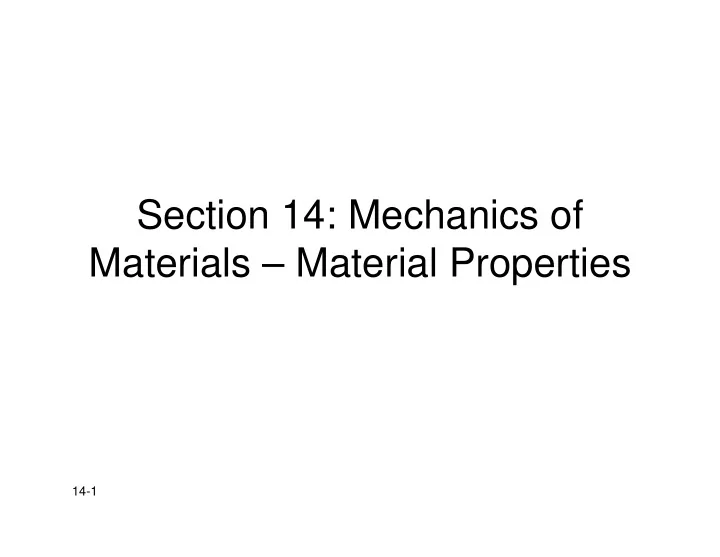

Section 14: Mechanics of Materials – Material Properties 14-1
Stress &Strain Stress &Strain • Stress-strain ratio: stiffness or compliance of the material A – E = σ / ε / ε E = σ • Linear material – Hooke’ law: σ = E· ε B • Biological material non- linear due to its tissue fluid component fluid component ε (viscoelastic properties) 14-2 From: Noffal
1. General mechanics principle • The underlying mechanics principle for metal forming is the stress-strain relationship; see Figure 1. 14-3 From: Zhang
Stress vs Strain Stress vs. Strain δ F σ σ = = ε = ε = Strain: S S Stress: A l Hooke’s law: σ = ε E Where: E = Modulus of Elasticity σ = stress ε = strain For the bike fork material E = 29.0 x 10 6 psi. 10 6 F th bik f k t i l E 29 0 i 14-4 From: Gateway Engineering Education Coalition
Strain Strain • Change in shape or Change in shape or deformation ( ε ) • Absolute strain • Relative strain – Δ L/L o 14-5 From: Noffal
Poisson's ratio : For a homogeneous isotropic material + Δ d d d F F x x l l x ε = • normal strain : normal strain : l l Δ d ε L = • lateral strain : l t l t i d ν ≡ − ε ε • Poisson's ratio : / L • value of ν : 0.2 - 0.5 14-6 From: Ong
Definition of Strain and Poisson’s Ratio: R i − ) Δ Δ ( ( l l l l ) l l ε = = i o l l o o •This is the definition of engineering strain. ν = ε x / ε z •In this definition, l 0 is the initial length of the specimen; l is the specimen; l i is the instantaneous length of the specimen; Δ l is the difference between the two. 14-7 From: Wei
Viscoelasticity Viscoelasticity • Pure elastic material – strain energy returned – no energy loss • Viscoelastic tissues Vi l ti ti Elastic – lose energy due to heat – energy is not returned σ σ Non immediately – Resilient – Dampened p • Hysteresis: area representing energy lost ε 14-8 From: Noffal
Viscoelasticity Viscoelasticity • Creep response Creep response creep • Stress-relaxation ε response p • Effects of strain-rate on stress relaxation σ 14-9 From: Noffal Time
Recommend
More recommend